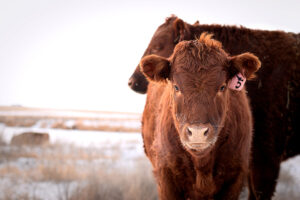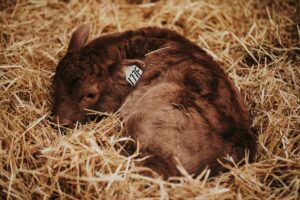Microbiome - les petites choses peuvent signifier beaucoup 🎙️
Cet article rédigé par le Dr Reynold Bergen, directeur scientifique du BCRC, a été initialement publié dans le numéro de janvier 2025 du magazine Canadian Cattlemen et est reproduit sur BeefResearch.ca avec la permission de l’éditeur.
CLIQUEZ SUR LE BOUTON « PLAY » POUR ÉCOUTER CET ÉPISODE (article offert en anglais seulement):
Écoutez d’autres épisodes sur BeefResearch.ca, Spotify, Apple Podcasts, Amazon Music ou Podbean.

Un « microbiome » est l’ensemble des microbes (bactéries, champignons, virus et leurs gènes) vivant dans un environnement spécifique, et la manière dont ils interagissent les uns avec les autres. Les animaux ont plusieurs microbiomes. Il existe un microbiome oral (la bouche et tous les microbes qu’elle contient), ainsi que des microbiomes nasal, respiratoire, du rumen, intestinal, vaginal, rectal et cutané. Les différents microbiomes interagissent entre eux et avec l’animal hôte.
Les animaux sont dépassés en nombre par ces locataires microbiens. Je me considère comme un être humain, mais la plus grande partie de mon corps ne l’est pas. Si je pouvais séparer toutes les cellules de mon corps en un tas de cellules humaines et un tas de cellules microbiennes, le tas de cellules microbiennes serait le plus important. C’est également vrai pour vous, et c’est encore plus vrai pour les bovins, car le rumen et les gros intestins sont des cuves de fermentation microbienne géantes.
Le point clé du « microbiome » est que les microbes et les cellules animales interagissent entre eux et avec l’environnement dans lequel ils se trouvent. Cela est particulièrement évident lorsque les populations microbiennes sont déséquilibrées. La maladie respiratoire bovine, l’acidose du rumen, le ballonnement et les abcès du foie sont tous des exemples d’un microbiome déréglé.
Les changements alimentaires peuvent modifier temporairement les populations microbiennes, mais il est très difficile de modifier de façon permanente un microbiome établi. C’est l’une des raisons pour lesquelles tant de probiotiques commerciaux destinés à « réparer » ou à améliorer le microbiome doivent être administrés en continu (et donnent des résultats irréguliers).
Il pourrait être plus efficace d’intervenir tôt dans la vie, alors que les différents microbes sont encore en train de s’organiser. C’est là que se concentre actuellement une grande partie de la recherche sur le microbiome.
Nilusha Malmuthuge (Centre de recherches de Lethbridge d’Agriculture et Agroalimentaire Canada) et Leluo Guan (Université de la Colombie-Britannique) ont récemment fait le point sur l’état de la science du microbiome bovin (Impact of maternal health and nutrition on the microbiome and immune development in neonatal calves; doi.org/10.3168/jds.2024-24835).
Ce qu’ils ont fait
Ils ont examiné et résumé les publications scientifiques sur le développement du microbiome chez l’humain, les animaux de laboratoire et le bétail. Il existe sans doute des différences entre les espèces, mais il y a aussi des principes communs qui s’appliquent aux différentes espèces.
Ce qu’ils ont appris
Le microbiome commence à se développer bien plus tôt que je ne le pensais.
La petite enfance : Des recherches comparant la progéniture de souris ayant un microbiome normal à la progéniture de souris dépourvues de germes ont montré que le développement normal du système immunitaire dépend de la colonisation précoce du microbiome. Les veaux nouveau-nés sont évidemment exposés à une vaste gamme de microbes provenant à la fois de la mère (pis et colostrum) et de l’environnement dans lequel ils sont nés. Au cours des premières heures de vie, le colostrum contourne le rumen du veau et se rend directement dans l’intestin grêle. La paroi intestinale comporte de nombreuses cellules spécialisées. Certaines de ces cellules spécialisées absorbent les anticorps maternels du colostrum qui protègent le veau contre les maladies. D’autres cellules fournissent des sites où les microbes peuvent commencer à coloniser. Ces microbes semblent aider le veau à absorber les anticorps maternels. Comme dans les études sur les souris, il semble que les microbes et le système immunitaire du veau influencent chacun le développement de l’autre. On ne sait pas exactement comment cela se produit, mais il semble probable que l’environnement du vêlage (par exemple, pâturage ouvert ou étable), la saison (par exemple, sol gelé ou boue) et les conditions de l’enclos (sol boueux ou sol sec ou bien garni de litière) influencent la façon dont le microbiome et l’immunité se développent dans l’intestin et les voies respiratoires du veau.
Le vêlage influence le microbiome. Lors de vêlages normaux, les microbiomes buccal et respiratoire sont « ensemencés » lorsque le veau passe par le canal de naissance. Mais les vêlages difficiles peuvent causer encore plus de problèmes que ce que nous savions déjà. Chez l’humain, un accouchement prolongé augmente la probabilité de troubles liés au microbiome chez la progéniture. Ces troubles comprennent les allergies, l’asthme, l’autisme, les cancers colorectaux, le diabète, l’eczéma, les maladies inflammatoires de l’intestin et l’obésité. L’avenir nous dira si les problèmes de vêlage prédisposent les veaux à des maladies telles que la diarrhée, les troubles de la reproduction, la grippe bovine ou les abcès du foie.
Nutrition des vaches gestantes : Les fondements d’un microbiome sain commencent bien avant la naissance. Chez l’humain, des études ont montré que les niveaux de graisse, de fruits, d’huiles végétales et d’acides gras alimentaires spécifiques consommés par la mère pendant la grossesse peuvent avoir un impact sur le système immunitaire, le microbiome et les résultats sur la santé (en particulier les allergies) de leurs enfants. Chez les vaches gestantes, la recherche a montré que le programme de vitamines et de minéraux peut influencer la taille et la composition du microbiome intestinal que le veau développe après la naissance, possiblement en influençant les microbes présents dans le colostrum. L’alimentation de la vache gestante peut également avoir un impact sur la façon dont le système immunitaire du veau réagit aux vaccins avant et après le sevrage.
En bref
Restez branchés. Les recherches en cours permettront de déterminer si des changements mesurables dans la composition du microbiome du veau nouveau-né ont des répercussions pratiques et économiques significatives sur la santé, la croissance et la fertilité à long terme du veau.

Qu’est-ce que cela signifie pour vous ?
Pendant que nous attendons ces réponses, utilisez ce que vous savez déjà. Accordez une attention particulière à votre programme d’alimentation hivernale et à la note d’état corporel des vaches. Ces choses aideront le veau fœtal à se développer normalement, réduiront les risques de difficultés de vêlage, produiront un colostrum nutritif contenant beaucoup d’anticorps. Tout cela contribuera à donner aux veaux un bon départ dans la vie. Certains veaux auront néanmoins besoin d’aide. Plus de la moitié des décès de veaux avant le sevrage surviennent dans les 24 premières heures de vie. Les ressources 911 pour veaux du BCRC peuvent vous aider à aider les veaux en détresse à traverser cette période critique. Considérant les prix actuels, le temps passé à trouver et à sauver quelques veaux supplémentaires vaut probablement l’effort (même s’ils ne feront peut-être pas des remplaçants de qualité).
Le Beef Cattle Research Council est une organisation industrielle à but non lucratif financée par le Prélèvement canadien sur les bovins de boucherie. Le BCRC s’associe à Agriculture et Agroalimentaire Canada, aux groupes provinciaux de l’industrie du bœuf et aux gouvernements pour faire progresser le transfert de recherche et de technologie à l’appui de la vision de l’industrie canadienne du bœuf, qui est d’être reconnue comme un fournisseur privilégié de bœuf, de bovins et de génétique sains et de haute qualité. Pour en savoir plus sur le BCRC, consultez le site www.beefresearch.ca.
Le partage ou la réimpression des articles du www.BeefResearch.ca est généralement bienvenu et encouragé, mais cet article nécessite l’autorisation de l’éditeur d’origine.
Vos questions, commentaires et suggestions sont les bienvenus. Contactez-nous directement ou suscitez un dialogue public en publiant vos réflexions ci-dessous.